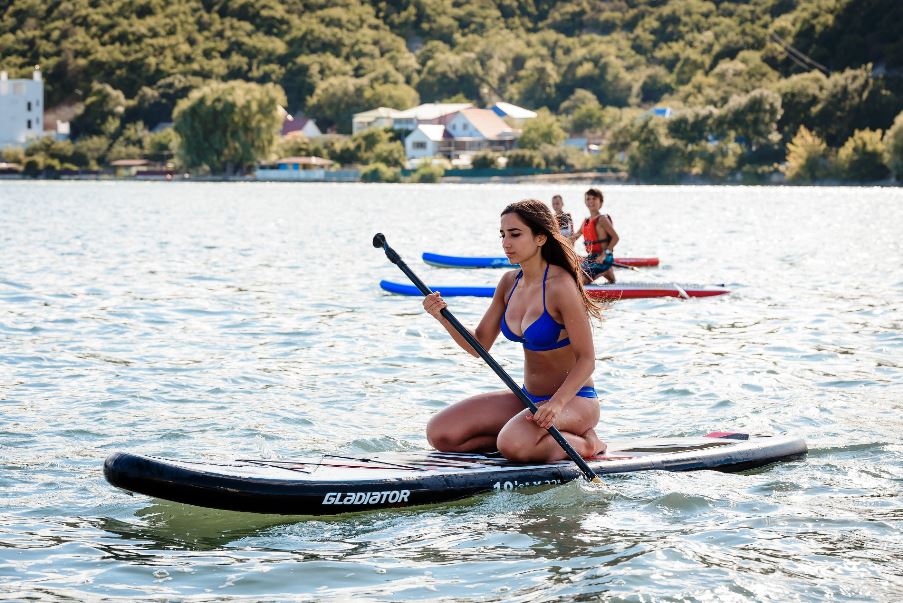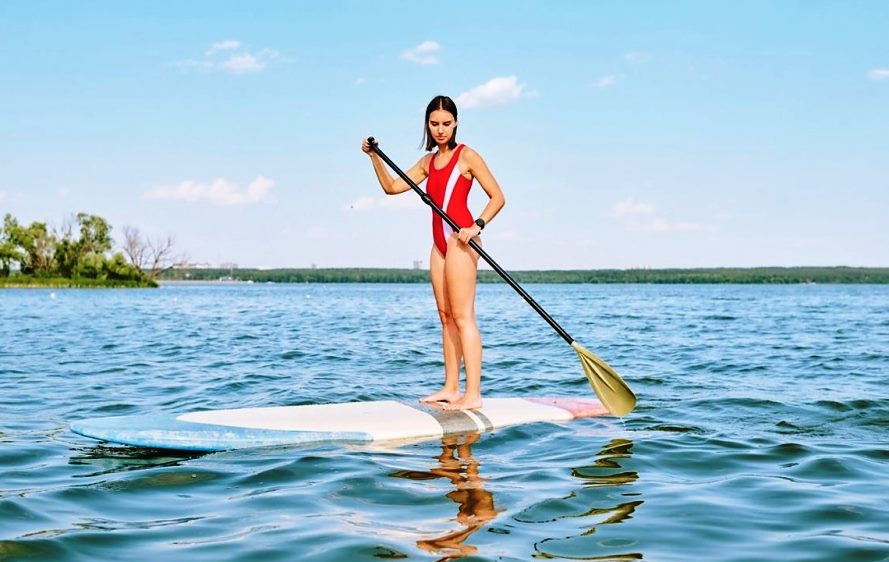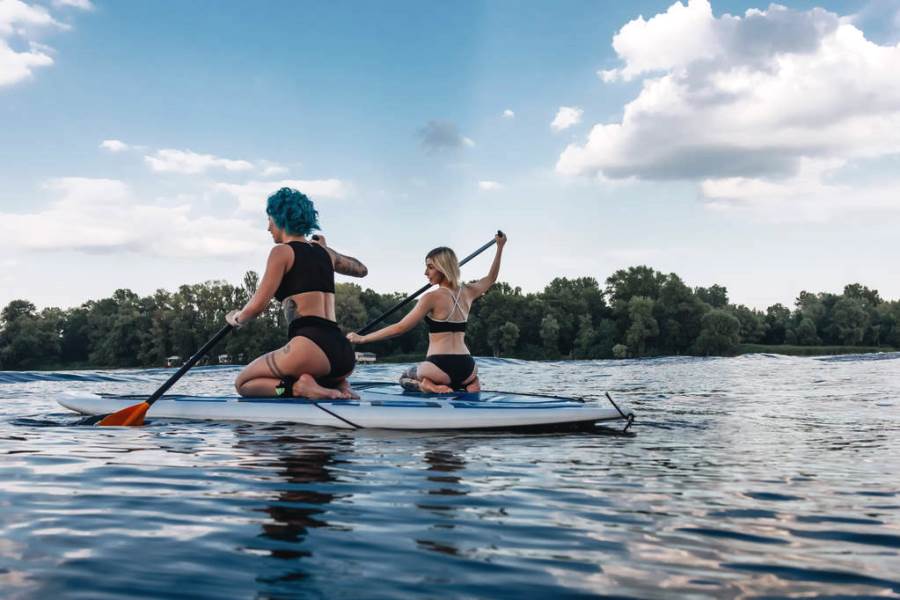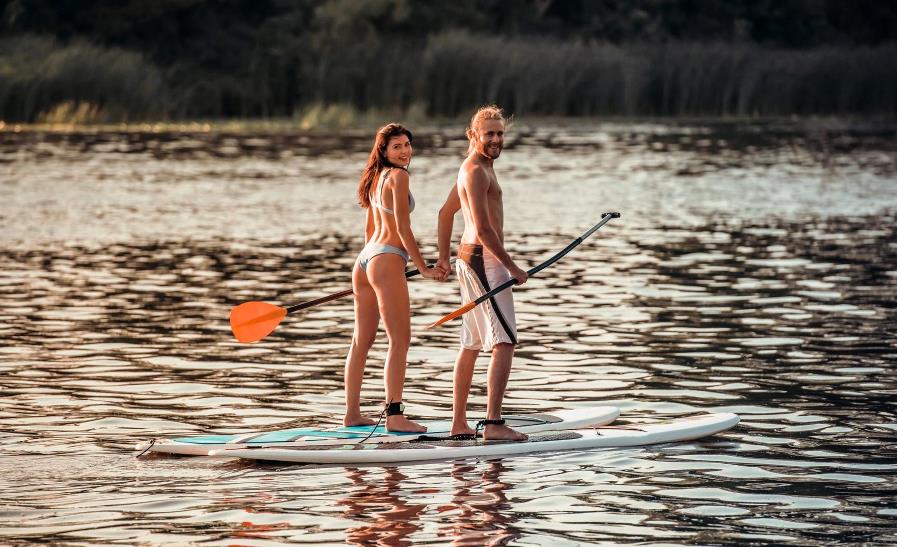SUP surfing for beginners
17.09.2021
2043
SUP surfing or SUP boarding is a water sport in which a surfer moves through the water by paddling while standing on a board.
What is SUP surfing?
This sport is often called standup paddleboarding. board race. SUP-surfing competitions are held on the coasts of oceans, seas, lakes and other water bodies, in which there are suitable waves.
The history of SUP surfing is very short but this type of sport has already become very popular. The birthplace of stand-up paddleboarding is Hawaii. It quickly spread around the world, winning the hearts of many water sports enthusiasts.
Boards for this sport are very similar to traditional surfboards but exceed them in size. So, the length of the board for SUP-surfing can reach 4.5 metres which allows the athlete to simplify maintaining balance on the water.
Paddle surfing is a universal type of outdoor activity that is suitable for both those who are accustomed to live without haste and those who wish to make their lives more active and energetic. SUP surfing is suitable for people with different preferences and abilities. This entertainment does not require such a serious level of training as traditional surfing and is available to both children and the elderly.
The main advantage of this sport is that the wind is not important for it: the surfer does not need to calculate the height of the waves and take risks relying on weather forecasts. For SUP surfing, the depth of the reservoir is not important either.
Another advantage of paddle surfing is that it is easy to learn. The main requirement for a beginner is the ability to swim. Learning how to SUP surf is not difficult at all: you just need to stand on the board and learn how to balance. This stage rarely takes more than a few hours even for riders with poor coordination.
SUP surfing does not require any additional specialised equipment. In order to practice this sport, a beginner only needs to purchase a SUP board and a paddle.

Types of SUP surfing
There are five varieties of SUP-surfing, each of which has its own characteristics.
SUP racing
SUP racing is a high-speed type of surfing in which the rider stands on a SUP board and rows with an oar, moving across the water surface at the highest possible speed. In SUP races surfers cover a predetermined distance. In surfing in this style world competitions are regularly held.
SUP racing boards are made with great care. In this style every centimetre of the board is important, the so-called shape (length, width and sharpness of the nose) and the fin system. Racing boards are very narrow and long - it is this shape of the SUP board that allows the rider to achieve high speed.
SUP on stormy rivers
This type of SUP boarding is one of the oldest and most extreme. In the process of rafting on a turbulent river, the sap-rider overcomes the rapids, standing on the board. This is the most demanding type of surfing in which equipment is extremely important. To protect yourself, before rafting, the rider puts on a helmet, knee pads, elbow pads and a life jacket. A high level of physical fitness is also important.
Water SUP boards have an ultra-stable construction and rather short shapes. They are manoeuvrable and maximally adapted for the most extreme type of paddle surfing.

SUP tourism
In English, this type of surfing is called SUP-travel or SUP-touring. This style is the most popular in SUP. With him, beginners in this sport most often begin.
SUP-tourism is measured swimming on a board in calm weather. With the help of a tourist SUP board, travellers often explore the coastal area while on the water. Tourist paddle boards are valued for their performance. Such boards are made with cargo fastening in the bow and in the stern.
SUP downwind
Downwind style is most popular among those athletes who have already mastered SUP surfing and want to develop their skills. For such surfers it is often not enough to calmly paddle a SUP paddle on a tourist board and they go to surf the stormy sea waves.
Translated from English, downwind literally means riding far from the coast in the direction of the wind. When riding in the style of downwind, you should calculate your strength with particular punctuality so as not to spend it halfway. There is no need to rush: in downwind, it is not speed that matters, but the accuracy and thoughtfulness of movements.
SUP-yoga and SUP-fitness
The most exotic type of SUP-surfing with a paddle is SUP for yoga and fitness. Various asanas are performed on SUP boards, strength and aerobic training take place. There are no competitions within this style. This is a local discipline, which is aimed at pumping all muscle groups, developing coordination and balance.
It is important that SUP boards are stable. Such boards are very wide and voluminous, equipped with a mat that covers the entire deck.
When choosing a type of paddle surfing, a beginner should carefully weigh their preferences and physiological capabilities. SUP tourism is suitable for the elderly and children, strong boys and girls with hard and enduring muscles - SUP on stormy rivers or SUP downwind.
SUP surfing is a unique outdoor activity with which you can tone your body and spirit. Passion for surfing is a great opportunity to make a lot of new acquaintances and see the most colourful corners of our country and the world. Do not forget about safety rules, train with an instructor, and you will become a confident SUP surfer in a matter of months.

Types of SUP boards, and what should be taken into account by a beginner when
SUP boards differ in shape, size, materials and, accordingly, in purpose. According to a common classification, boards of several types are distinguished.
- Touring. SUP boards for long distance water trips. To reduce the effort applied by the rider, while remaining stable, the board has a slightly pointed part with a wide stern. Many manufacturers provide a net on the board for securing loads. Compared to other types of SUP boards, touring boards are wider. Length is 11-13.2 feet (335.28-402.34 cm), width - 73-81 cm (standard - up to 76 cm).
- WindSUP boards. Boards with a mortgage for the installation of a mast with a sail. These are inflatable windSUPs with an additional central fin. If you want to master not only stand-up paddleboarding, but also windsurfing on a river or sea, then you can choose such a board for a beginner.
- Sport SUP boards (racing). Long short boards with low stability, but high speed performance. Standard length: 12.6-14 feet (384.05-426.72 cm), width - 60-73 cm. Not recommended for beginners.
- Walking (Travel). The most versatile SUP boards suitable for beginners. They have average characteristics in terms of stability, speed and controllability. Used for leisurely riding on calm waters, on light waves. The length averages 10-11 feet (304.8-335.28 cm), although there are models for 9.6 (292.61) and 12.6 feet (384.05 cm). Width - from 80 cm.
There are also «exotic» types of boards: Big SUP for a company of 3 people, boards for yoga, for descending mountain rivers.

How to choose a SUP board for a beginner?
If a person has never tried himself in SUP, then the first board should be a walking board. At the initial stages, it is important to learn how to balance and properly row, manage, «feel» the board. Only after that should you get up on touring and other SUP boards.
When choosing, several factors are taken into account.
- Sizes. The wider the board, the more stable it is on the water, the lower the risk of falling off the stern. But wide boards have worse handling - they are optimal for a leisurely walk along a straight path with a large turning radius.
- Load capacity. It is better to choose a board with a margin for maximum load capacity. The larger this indicator, the larger the board sizes in one class, and, accordingly, the worse the manoeuvrability.
- Speed. Beginners should not strive to accelerate the board to high speeds, anyway sports SUP-boards are intended for this purpose, and it will not be possible to master them without experience.
- Weight. The better the PVC and the board itself, the less weight it will have with the same characteristics compared to cheaper boards. Carrying 10-12 kg in your hands every day, if there is no direct access to the reservoir, will be tiring for a long time.
- Paddle. In the kit, boards from well-known manufacturers usually do not have oars. For a beginner, a lightweight, durable carbon paddle with a nylon blade is suitable.
- Design. SUP boards are rigid and inflatable. Here the question of choice is determined by the complexity of delivery and ease of storage. Inflatable PVC boards can also be stored in the trunk of a car, taken with you when going out into the countryside.
You can also learn how to ride a SUP board on your own, but it’s better if a coach or a professional and experienced SUP surfer helps you with the choice of board and the basic rowing technique.
